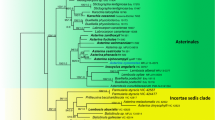Abstract
Partial ribosomal RNA nucleotide sequences were determined for 11 strains ofFusarium sambucinum Fuckelsensu lato to assess by molecular genetic means, Nirenberg's recent morphotaxonomic interpretation which split the species into three distinct taxa:F. sambucinum sensu stricto, F. torulosum, and one other species, as yet unnamed (Fusarium species nova). Four sequence patterns were identified among the 11 strains. Two sequences that varied at one site were found among strains ofF. sambucinum, strains ofF. torulosum andFusarium sp. nov. showed no intraspecific variation. Interspecific comparisons revealed nucleotide sequence differences of 3–9 substitutions in the ca. 240 nucleotide rRNA segment examined. Although interspecific differences are not large in terms of percent nucleotide substitution, they are much larger than the observed intraspecific variation and support the morphological interpretation distinguishing three taxa. When the data were analysed using parsimony and bootstrapping, the three taxon tree was well supported. The phylogenetic arrangement of these strains is congruent with secondary metabolite profile similarities.
Similar content being viewed by others
References
Booth C. The genusFusarium. Kew: Commonwealth Mycological Institute, 1971.
Boyd AE. Potato storage diseases. Rev Plant Pathol 1972; 51: 297–321.
Marasas WFO, Nelson PE, Toussoun TA. ToxigenicFusarium species: Identity and mycotoxicology. University Park, PA: Pennsylvania State University Press, 1984.
Gerlach W, Nirenberg H. The genusFusarium: A pictorial atlas. Mitt Biol Bundesanst Land-Forstwirt. Berlin-Dahlem 1982; 209: 1–406.
Nelson PE, Toussoun TA, Marasas WFO.Fusarium. University Park, PA: Pennsylvania State University Press, 1983.
Wollenweber HW, Reinking OA. Die Fusarien, ihre Beschreibung, Schadwirkung und Bekämpfung. Berlin: Paul Parey, 1935.
Thrane U.Fusarium species and their specific profiles of secondary metabolites. In Chelkowski J, ed.Fusarium Mycotoxins, taxonomy and pathogenicity. Amsterdam: Elsevier, 1989; 199–225.
Desjardins AE, Plattner RD. Trichothecene toxin production by strains ofGibberella pulicaris (Fusarium sambucinum) in liquid culture and in potato tubers. J Agric Food Chem 1989; 37: 388–92.
Ellis JJ. SectionLiseola ofFusarium. Mycologia 1988; 80: 225–28.
Guadet J, Julien J., Lafay JF, Brygoo Y. Phylogeny of someFusarium species, as determined by large-subunit rRNA sequence comparisons. Mol Biol Evol 1989; 6: 227–42.
Kurtzman CP. Molecular taxonomy of fungi. In Bennett, JW Lasure LL, eds. Gene manipulation in Fungi. New York: Academic Press, 1985; 35–65.
Logrieco A, Peterson SW, Bottalico A. Phylogenetic affinities of the species inFusarium sectionSporotrichiella. Experimental Mycology 1991; 15: 174–79.
Peterson SW, Logrieco A. Ribosomal RNA sequence variation among interfertile strains of someGibberella species. Mycologica 1991; 83: 397–402.
Wickerham LJ. Taxonomy of yeast. US Dept Agric Tech Bull 1951: 1–56.
Chirgwin JM, Przybyla AE, MacDonald RJ, Rutter WJ. Isolation of biologically active ribonucleic acid from sources rich in ribonuclease. Biochemistry 1979; 18: 5294–99.
Lane DJ, Pace B, Olsen GJ, Stahl DA, Sogin ML, Pace NR. Rapid determination of 16S ribosomal RNA sequences for phylogenetic analysis. Proc Natl Acad Sci (USA) 1985; 82: 6955–59.
Georgiev OI, Nikolaev N, Hadjiolov AA, Skryabin KG, Zakharyev VM, Bayev AA. The structure of the yeast ribosomal RNA genes, 4: Complete sequence of the 25S rRNA gene fromSaccharomyces cerevisiae. Nucleic Acids Res 1981; 9: 6953–58.
Felsenstein J. Phylip version 3.4.1991. Seattle: University of Washington.
Golinski P, Vesonder RF, Latus-Zietkiewicz D, Perkowski J. Formation of fusarenone X, nivalenol, zearalenone,a-transzearalenone, and fusarin C byFusarium crookwellense. Appl Environ Microbiol 1988; 54: 2147–48.
Desjardins AE, Beremand M. A genetic system for trichothecene toxin production inGibberella pulicaris (Fusarium sambucinum). Phytopathology 1987; 77: 678–83.
Peterson SW, Kurtzman CP. Phylogenetic relationships among species ofIssatchenkia. Ant Leeuwenh 1990; 58: 235–40.
Bottalicao A, Logreico A, Visconti A. Mycotoxins produced byFusarium crookwellense. Phytopath Medit 1990; 29: 124–27.
Vesonder RF. Diacetoxyscripenol, nivalenol, fusarin C and zearalenone formation by geographic isolates ofFusarium crookwellense from potato, grain and pature herbage. Phytopathology 1989; 79: 488 (Abst.).
Author information
Authors and Affiliations
Rights and permissions
About this article
Cite this article
Logrieco, A., Peterson, S.W. & Bottalico, A. Phylogenetic relationship withinFusarium sambucinum Fuckel sensu lato, determined from ribosomal RNA sequences. Mycopathologia 129, 153–158 (1995). https://doi.org/10.1007/BF01103340
Received:
Accepted:
Issue Date:
DOI: https://doi.org/10.1007/BF01103340




